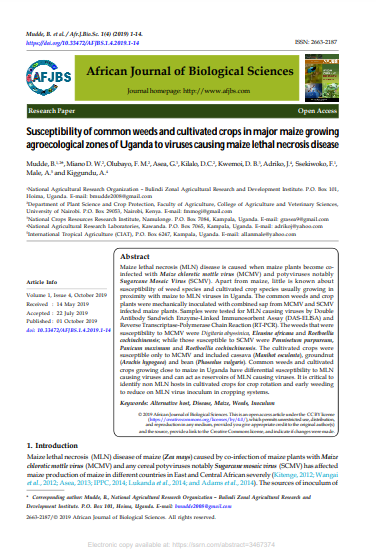Maize lethal necrosis (MLN) disease is caused when maize plants become co-infected with Maize chlorotic mottle virus (MCMV) and potyviruses notably Sugarcane Mosaic Virus (SCMV). Apart from maize, little is known about susceptibility of weed species and cultivated crop species usually growing in proximity with maize to MLN viruses in Uganda. The common weeds and crop plants were mechanically inoculated with combined sap from MCMV and SCMV infected maize plants. Samples were tested for MLN causing viruses by Double Antibody Sandwich Enzyme-Linked Immunosorbent Assay (DAS-ELISA) and Reverse Transcriptase-Polymerase Chain Reaction (RT-PCR). The weeds that were susceptible to MCMV were Digitaria abyssinica, Eleusine africana and Roetboellia cochinchinensis; while those susceptible to SCMV were Pennisetum purpureum, Panicum maximum and Roetboellia cochinchinensis. The cultivated crops were susceptible only to MCMV and included cassava (Manihot esculenta), groundnut (Arachis hypogaea) and bean (Phaseolus vulgaris). Common weeds and cultivated crops growing close to maize in Uganda have differential susceptibility to MLN causing viruses and can act as reservoirs of MLN causing viruses. It is critical to identify non-MLN hosts in cultivated crops for crop rotation and early weeding to reduce on MLN virus inoculum in cropping system.
Mudde, B.; Miano D.W.; Olubayo, F.M.; Asea, G.; Kilalo, D.C.; Kwemoi, D.B.; Adriko, J.; Ssekiwoko, F.; Male, A.; Kiggundu, A.

